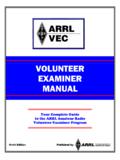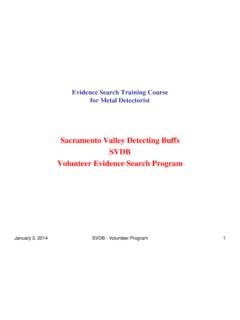Transcription of HamElmer.com Technician Test Self Study Guide
1 Technician Test self Study Guide Figure 1 - WB5 ACN at the San Antonio Radio Club Field Day 2003. Photo by N5 NTG. Version 6/19/2007 Since February, 23 2007 No Morse Code is required for any Amateur Radio License! Version SECOND PRINTING May 2007 This Guide is available for any non-profit and non-commercial use. Please email any corrections or omissions to The source documents used to create this Guide are: Technicians Question Pool (February 6th, 2006 Release) for tests after July 1stth, 2006 till June 30, 2010. Amateur Radio Rules, Code of Federal Regulations Title 47, Volume 5 Part 97. The source information is available to the public. If you have any questions or comments please post a message at Fo r w a r d The Radio Teacher Project, now called , goal is to provide free documentation for Amateur Radio tests .
2 In early 2006 Google started giving 100 MB of web space for free to its registered users. Using an email account for RadioTeacher the web site was created as for the project. The San Antonio Radio Club needed an instructor in 2001 to teach the Technicians class and I gladly accepted the job. I feel that the only way to grow the hobby was to teach and Elmer (the Amateur Radio term for mentor) anyone with a desire to become an amateur radio operator. I owe a lot to the hobby/service. In the 1980 s I worked as a laborer and carpenter on the coast of South Texas. In December of 1986 I earned a Technicians license as N5 IUT. In a short time I was communicating over packet radio to San Antonio 150 miles away via a digipeater to Harry Ridenour, N0 CCW on two meters. Harry was the first radio operator on packet radio in San Antonio and a wealth of packet radio information.
3 Harry (my Elmer) and my father encouraged me to learn more about packet radio, computers and build many projects. My father Louis, N5 JKH, and I installed and maintained many Packet Radio nodes during that time. In 1991 with a practical knowledge in computers and networking I changed careers to computers. I owe the success of my career to Amateur Radio. Paul Guido, N5 IUT Editor, 6/19/2007 Page i Dedication This work is dedicated to my friend and Elmer, Harry Ridenour, N0 CCW (SK) and my friend Carl Ray Finke, W5 CRF (SK). Acknowledgements Ed Franks, KE5 CAX and his wife Roberta for their help in pointing out an error the Study Guide version that is now corrected.
4 I would like to thank Bob Bytheway, K3 DIO for his steady hand, help and encouragement at every phase of this project. Les Warriner, WA7 HAM for his editing skills and ideas that made this a much better document. Alan Sewell, N5NA for helping me find the XML version of the Technicians Question Pool and running a great web site full of information for students and instructors. Thank you for linking to this Guide from your site. Earl Paazig, N8 KBR for providing me his Study Guide on the new pool that accelerated the development of this Guide . He also runs a very informative web site that is a great resource for all Amateur Radio tests . Michael Ballbach, N0 ZTQ for making the file available on his web site at Mike Anderson, N4 MAA from St. Petersburg, Florida for his assistance and providing an alternate location to host this document at Page ii 6/19/2007 How to use this Study Guide Read each chapter and answer the review questions at the end of chapters.
5 Each chapter should only take 10 to 30 minutes to complete. After reading the Guide , take some practice tests . You can do this by using the free software from The best free Internet site for taking practice tests is Ron has done a great job of programming a first class testing site. Other Internet sites for testing are At you can print a test to take later. at is a popular practice test site. Write down information about the questions that you missed. Then you can lookup more information on the topics in this Guide or online. There is a glossary in Appendix B and a full index to the Guide in Appendix D. Search for information on the Internet using: this is Google s main search page. Wikipedia, the free encyclopedia. If this does not help, post a message to the Ham Radio Help Yahoo Group.
6 It is the best group on the Internet to ask an Amateur Radio related question. This self Study Guide is a work in progress. Check to see if you have a recent version of the Guide by visiting: Test Session information: Some Volunteer Examiners accept walk in applicants others do not, please contact the VE team that you will be testing with to find out their policy. The Technician test (Element 2 is the formal name of the test) is 35 questions and is not timed. It is a written test with multiple choice questions. To pass you must get at least 26 of the 35 questions correct (74%). The price currently set on the test is $ Taking a check or the exact change is nice for the VE team. Most VE teams require two forms of identification (a photo ID plus another ID). Also, take a blue or black pen, and a calculator.
7 6/19/2007 Page iii If you are consistently passing the practice tests , find a test session in your area by searching here: and choosing Exams in the search box. Figure 2 - Screenshot of search box. Get to the test session early. The Volunteer Examiner (VE) in charge of the session will normally go over the procedures and policies of the session. Feel free to ask anyone on the VE team questions. If you have a disability or special needs, contact the VE team prior to the session to see if they have the resources to accommodate. When finished with the test pass it back to the VE team for grading.
8 A VE team member will call you over with the results you pass give you a CSCE for credit. The VE team will turn over the results of the session to their Volunteer Examiner Coordinator (VEC). The VEC will send the information to the FCC. The FCC will update its database and your new callsign will be listed on the Internet. You will be able to find your new callsign by searching the ULS database at . You can start using your privileges as an Amateur Radio Operator as soon as your name and callsign appears in the ULS database. More Information: If you complete this Guide and still need more information to pass the test please try the following books and training. Please make sure that the book you buy covers the current test. ARRL Ham Radio License Manual, from or Gordon West s Technician Book, from If you learn better in a classroom environment locate a club in your area by searching at and choosing Clubs from the search box.
9 Then contact the local club to see when they are having classes. One Internet training site that is not free for Amateur Radio that I hear good things about is if looking to train online please check it out. The ARRL also provides online training. Page iv 6/19/2007 Guide Sources and Layout: This Guide is based on the Technician s Question pool released on February 6, 2006. The editors of this Guide have included information and images to answer all 391 questions in this pool. Since this pool was released one question has been withdrawn. Chapter 1 of this Guide contains the information needed to answer the questions of subelement T1.
10 Chapter 10 corresponds with subelement T0 of the Technicians Question Pool. The text in each chapter was rearranged in an effort to keep like subject matter together. REACT International This Study Guide has received an endorsement from REACT International for the training of it membership. You can find out more about REACT International from their web site at Internet Links Online Training Links: This Study Guide has a new home at Please look to see if you have the latest version of the Study Guide . If you have any questions or comments about the Study Guide , please post a message at For some students this Guide has too many features of a text book. For a very well thought out Technician or General Study Guide that gets right to the point, please check out Dan Romanchik s, KB6NU, No-Nonsense Study guides.

